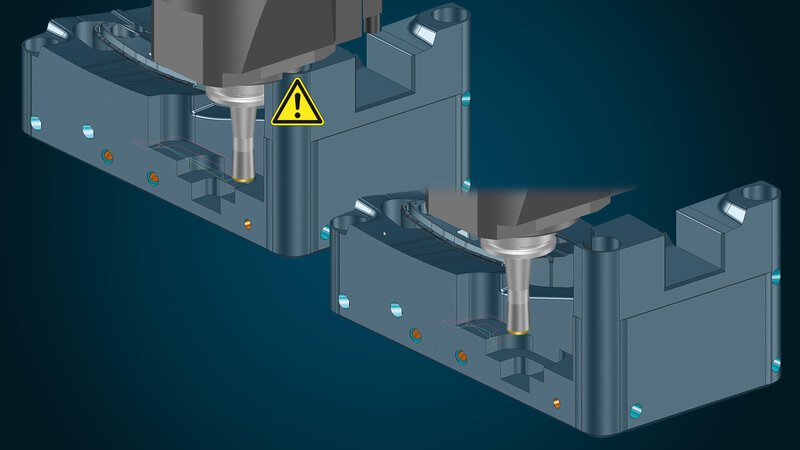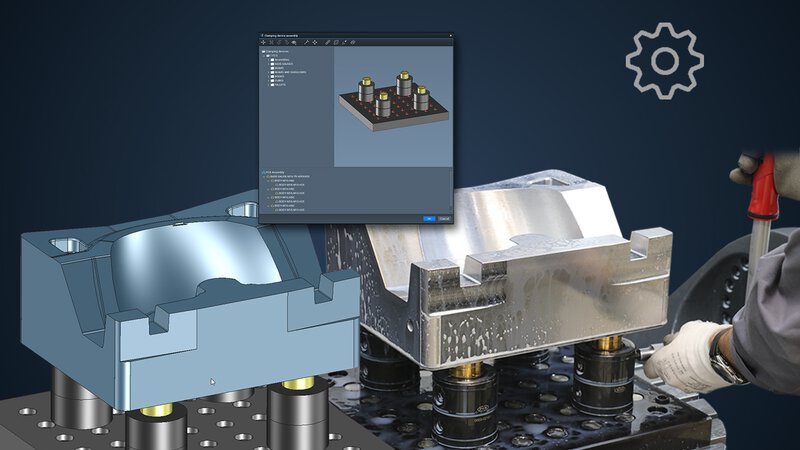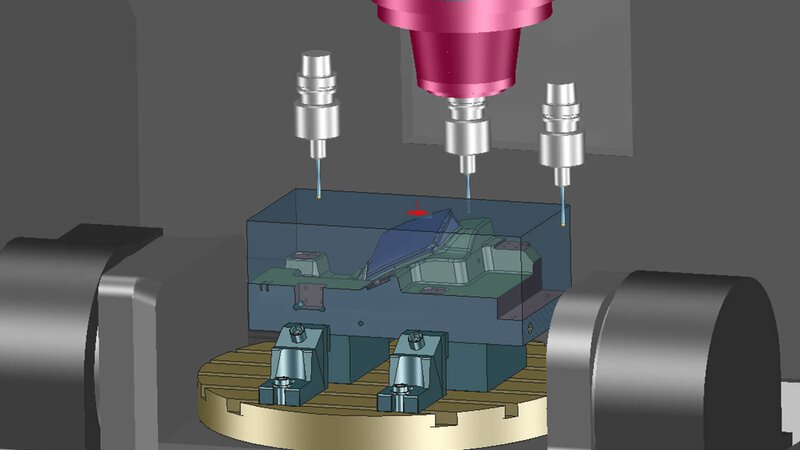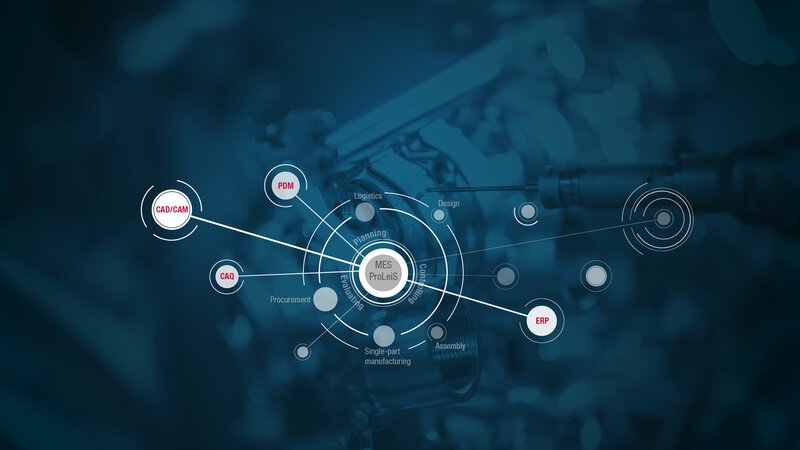The goal is 24/7
Meeting with Reiner Schmid, Head of Product Management
Efficiency, full utilization of machines, reduced-personnel manufacturing – these goals can only be achieved through the comprehensive automation of manufacturing processes. Tebis 4.1 provides the foundations with process libraries that have been extended to include the clamping device library, intelligent collision avoidance strategies, process-integrated measurement and ProLeiS MES. In this interview you’ll learn:
- Why you should automate your manufacturing processes
- Why you should move your decisions to the CAD/CAM software
- How you can boost the automation of your manufacturing processes with Tebis 4.1
- How Tebis 4.1 will keep your manufacturing productivity high even in unstable times
Why manufacturing processes should be automated to the greatest extent.
The goal is 24/7
Why manufacturing processes should be automated to the greatest extent.
Mr. Schmid, everyone’s talking about automation. You say that Tebis 4.1 is the platform for automating customer processes. What exactly does that mean?
Automation isn’t an end in itself. Manufacturing companies invest a lot in high-performance machinery. If they want to produce cost-effectively over the long term, the machines must run nonstop, 24/7 if possible. Without automation, there are too many obstacles in the way.
Do you mean examples like machine damage from collisions that could have been avoided by automation?
Of course, machine damage is the most obvious worst-case scenario. Incidents like this cost significant time and money. Fortunately, this rarely happens.. However, this example very clearly demonstrates why automation is so important, even if the worst doesn’t happen right away. For relatively simple machines, an attentive machine operator might still be able to visually detect potential collisions and press the emergency stop button in time. But the movements in modern high-performance machines like turning/milling centers and simultaneous 5-axis machines are so fast and so complex that it´s nearly impossible to stop the machine manually. That's why most of these machines have integrated protection mechanisms. The machine stops automatically as soon as there’s a risk of collision.
Then it takes time for the error to be corrected and the machine to be restarted.
That's the first point. Secondly, this requires experienced specialists who know exactly what to do. Third, the correction also must be fed back into the CAM program. Because the error shouldn’t cause downtime again during the next run. Waiting to collision-check the machining operation before it reaches the machine makes it nearly impossible to manufacture with reduced personnel and essentially "around the clock."
Move decisions to the CAM software
Optimal use of resources
We’ve always strongly believed that as many tasks as possible – from collision checking, tool and machine selection, setup, machine assignment planning to quality control – should be performed in the CAM environment. Otherwise, we’re putting the cart before the horse. Because everything that isn’t determined before production can disrupt processes and cost unnecessary time and resources. Just selecting the machine opens an entire rat's nest of decisions: How to set up, which tools to use, how to move and retract them optimally while accounting for the machining space and how to clamp the component. This all needs to be decided in advance in a standardized way. That's why programming is performed in Tebis using the digital twin of the real manufacturing environment. The latest developments have again taken us a significant step forward in this area.
The machine head is fully accounted for in collision-checking
Safe manufacturing
Yes, for example. Collisions are already detected automatically in the software and are reliably prevented. Depending on the machining task and the machine, you can specify in CAM programming if you want to use 5-axis simultaneous collision avoidance or if you want indexed machining of the milling area. As a new alternative, you can automatically reduce the machining area and account for the entire head geometry. This works for both milling and turning. Standardized templates help with decision-making. The machine operator doesn’t have to worry about collisions and can instead just concentrate on production.
The clamping device library completes the virtual process libraries
Time-saving machine setup
Integration of the clamping device library in the virtual process libraries is an especially significant developmental step toward greater automation. It enables a complete setup of the machine in the virtual world, including multiple setups. Only clamping devices that fit on the selected machine are offered to the CAM programmer for setup. The user positions the reference point, places the clamping devices on the component with just a few clicks and then places the entire setup on the machine table.
This reduces the workload on the person responsible for setup on the machine.
Yes. Precise and detailed NC documentation is automatically generated as part of NC output. This provides an accurate result to the setup station. The person responsible for the setup can immediately see what needs to be done. Clear component designations show what clamping devices are needed. And how to position them.
Shorter setup and machining time with process-integrated measurement
Full control
What’s known as "process-integrated measurement" is another important building block for increasing manufacturing productivity with greater automation.
And that means?
The measuring cycles are integrated in the CAM programming. This results in higher component quality and prevents manual reworking: That’s because accuracy errors – for example, due to incorrect zeroing or uncontrolled tool wear – are detected and prevented at an early stage. The CAM programmer can simultaneously check to ensure that the part is correctly set up and that the blank is correctly dimensioned and oriented. All of this can be monitored automatically. This again prevents unnecessary downtime and even tool breakage or machine damage. You’ll benefit from these advantages on all controls, regardless of whether or not they have their own measuring cycles.
ProLeiS MES software fully integrated
Optimal manufacturing planning and controlling
By the way, this has also been improved in version 4.1. With ProLeiS and Tebis 4.1, you can split up entire assemblies and individual components into individual processing sequences. Even complex manufacturing projects can be planned, controlled and implemented. Logistics for purchased parts, blanks and machine components are also accounted for from end to end. Your machinery is always optimally utilized. All activities can be assigned to specific manufacturing designers, NC programmers and machine operators. In effect, it’s "automation plus.”
Keeping productivity high, even in turbulent times
Flexibility is key
The overall economic situation is very fragile. Long-term planning with reliable figures is becoming increasingly difficult. Our medium-sized companies are at risk because of international trade wars, price pressures due to globalization, the discussions about the future of the combustion engine and now the pandemic. And the companies have little influence on these factors. In 2019, the aviation industry was considered the ultimate industry of the future. Now the passenger sector has been hit with an extreme decline. In contrast, the entire manufacturing industry was under pressure even before the COVID-19 pandemic. When you compare the crisis of 2008/2009 with the current one, automotive suppliers were hit especially hard – and they still are struggling – relative to the medical technology industry, for example.
The manufacturing world is also becoming more and more complex, and the demands on manufacturing companies are increasing rapidly. But it’s precisely this development – the unpredictability of future demands and the high degree of complexity – that makes the automation of manufacturing processes even more important.
So companies can be more flexible with automated manufacturing processes?
Yes, that's correct. Automated manufacturing processes enable companies to better respond to changing market requirements. The infrastructure can be adapted more quickly, for example, if the range of components must be expanded to supply different industries. Or taking it a step further: Automated horizontal networking is simplified by MES software like ProLeiS that can also be easily combined as an integration platform with upstream and downstream systems like PDM, ERP and machine control systems. With service providers, for example. Or even with other suppliers. If the portfolio of products and services can be quickly modified, companies can even accept orders from industry colleagues or – vice versa – they can outsource their own orders to colleagues' machines. The goal must be: 24/7 operation with simultaneous high productivity.






